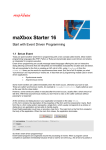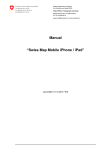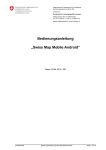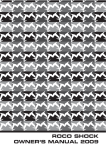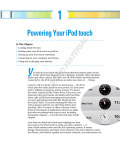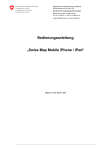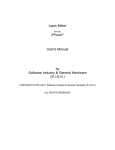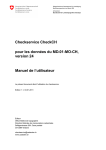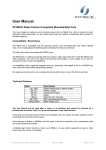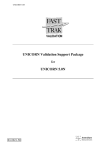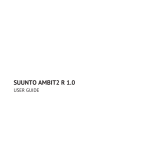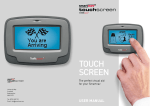Download Manual „Swiss Map Mobile iPhone / iPad Edition“
Transcript
Federal Department of Defence, Civil Protection and Sport DDPS armasuisse Federal Office of Topography swisstopo Seftigenstrasse 264, CH-3084 Wabern Tel. +41 31 963 21 11, Fax +41 31 963 24 59 [email protected], www.swisstopo.ch Manual „Swiss Map Mobile iPhone / iPad Edition“ Last edited: 31.01.2011 / KIK 20110131/KIK Manual „Swiss Map Mobile iPhone Edition“ page 1 of 35 Table of contents Introduction ............................................................................................................................... 5 iPad.......................................................................................................................................................5 1 Panning and zooming ........................................................................................................ 6 1.1 Description of functions .......................................................................................................... 6 1.2 Handling .................................................................................................................................. 6 1.2.1 1.2.2 1.3 2 3 Panning (manual move of the map) .................................................................................................... 6 Zooming in/out with gestures ............................................................................................................. 6 Further advice ......................................................................................................................... 7 Map selection ...................................................................................................................... 8 2.1 Description of functions .......................................................................................................... 8 2.2 Handling .................................................................................................................................. 8 Status bar ............................................................................................................................ 9 3.1 Description of functions .......................................................................................................... 9 3.2 Handling .................................................................................................................................. 9 3.2.1 3.2.2 3.2.3 4 GPS function ....................................................................................................................................... 9 Visualization of scale/coordinates/a.s.o. ........................................................................................... 10 Access to the main menu .................................................................................................................. 10 Map material..................................................................................................................... 12 4.1 Description of functions ........................................................................................................ 12 4.2 Handling ................................................................................................................................ 12 4.2.1 4.2.2 5 Display of activated sectors / available map tiles ............................................................................. 12 List of products ................................................................................................................................. 12 GPS mode ......................................................................................................................... 14 5.1 General information .............................................................................................................. 14 5.2 Description of functions ........................................................................................................ 14 5.3 Handling ................................................................................................................................ 14 5.3.1 5.3.2 6 7 8 GPS mode „Moving map“ ................................................................................................................ 14 Displaying blue and red arrow .......................................................................................................... 15 Calculation of distance ..................................................................................................... 16 6.1 Description of functions ........................................................................................................ 16 6.2 Handling ................................................................................................................................ 16 Place name search ............................................................................................................ 17 7.1 Description of functions ........................................................................................................ 17 7.2 Handling ................................................................................................................................ 17 POIs/waypoints ................................................................................................................. 18 8.1 Description of functions ........................................................................................................ 18 8.2 Handling ................................................................................................................................ 18 8.2.1 20110131/KIK Registering new POI/waypoint ......................................................................................................... 18 Manual „Swiss Map Mobile iPhone Edition“ page 2 of 35 8.2.2 8.2.3 8.2.4 8.2.5 9 Displaying POI/waypoint on the map............................................................................................... 19 Editing POI/waypoint ....................................................................................................................... 19 Import/export of POIs/waypoints or tracks via iTunes..................................................................... 19 Import of POIs/waypoints or tracks via e-mail................................................................................. 20 Tracks................................................................................................................................ 21 9.1 Description of functions ........................................................................................................ 21 9.2 Handling ................................................................................................................................ 21 9.2.1 9.2.2 9.2.3 9.2.4 9.2.5 9.2.6 9.2.7 9.2.8 9.2.9 9.2.10 Selecting track and displaying track on the map .............................................................................. 21 Displaying, editing and removing track properties........................................................................... 21 Recording track manually (GPS mode turned off) ........................................................................... 22 Recording track automatically (GPS mode turned on) ..................................................................... 23 Download of online tracks ................................................................................................................ 23 Import/export of POIs/waypoints or tracks via iTunes..................................................................... 23 Import/export of POIs/waypoints or tracks via e-mail ..................................................................... 23 Import of tracks directly from the internet ....................................................................................... 23 Show and hide track.......................................................................................................................... 24 Vocal navigation .......................................................................................................................... 24 10 Download map tiles .......................................................................................................... 25 10.1 Description of functions ........................................................................................................ 25 10.2 Handling ................................................................................................................................ 25 10.2.1 10.2.2 10.2.3 Area download ............................................................................................................................. 25 Map download along a track ........................................................................................................ 25 Download of all purchased maps ................................................................................................. 25 11 Hiking trails ...................................................................................................................... 26 11.1 General information .............................................................................................................. 26 11.2 Description of functions ........................................................................................................ 26 11.3 Handling ................................................................................................................................ 26 11.3.1 Purchasing and displaying hiking trails ....................................................................................... 26 12 Route calculation .............................................................................................................. 27 12.2 Description of functions ........................................................................................................ 27 12.3 Handling ................................................................................................................................ 27 12.3.1 12.3.2 12.3.3 12.3.4 12.3.5 12.3.6 12.3.7 Route calculation .......................................................................................................................... 27 Navigation current location (start) - goal ..................................................................................... 27 Jumping to the current goal .......................................................................................................... 28 Deleting goal(s) ............................................................................................................................ 28 Intermediate goals ........................................................................................................................ 28 Simulating start ............................................................................................................................ 29 Redefining route ........................................................................................................................... 29 13 SwitzerlandMobility .......................................................................................................... 30 13.1 General information .............................................................................................................. 30 13.2 Handling ................................................................................................................................ 30 13.2.1 13.2.2 13.2.3 Showing and hiding categories/POIs ........................................................................................... 30 Vocal navigation on SwitzerlandMobility routes ......................................................................... 31 Searching routes ........................................................................................................................... 31 14 Panorama and Augmented Reality .................................................................................. 32 14.1 Description of functions ........................................................................................................ 32 20110131/KIK Manual „Swiss Map Mobile iPhone Edition“ page 3 of 35 14.2 Handling ................................................................................................................................ 33 14.2.1 14.2.2 14.2.3 14.2.3 Access to functions ....................................................................................................................... 33 Augmented Reality settings ......................................................................................................... 33 Augmented Reality calibration ..................................................................................................... 33 Photo function .............................................................................................................................. 33 15 Other functions ................................................................................................................. 34 15.1 Description of functions ........................................................................................................ 34 15.2 Handling ................................................................................................................................ 34 15.2.1 15.2.2 Search for coordinates .................................................................................................................. 34 Determining the version ............................................................................................................... 34 Final remarks........................................................................................................................... 35 20110131/KIK Manual „Swiss Map Mobile iPhone Edition“ page 4 of 35 Introduction Prerequisite for an optimal usage of Swiss Map Mobile on the iPhone is some basic knowledge of the iPhone How-Tos. Consult: http://www.apple.com/support/iphone/basics/ A description of the application, map sections, tile packages and hiking trails sections is provided on the swisstopo website (http://www.swisstopo.ch/iphone). Also, extensive material to this manual as well as descriptions of officially unsupported functions is provided. See also http://www.swisstopo.ch/iphonefaq. Advice: Five gestures are distinguished when tapping on the iPhone screen: • Scrolling/panning (drag up, down or diagonally to scroll the map – manual download of tiles) • Tapping (single tapping with one finger) • Double tapping (quick double tapping with one finger) • Single tapping with two (slightly spread) fingers • Tapping (with one finger) and holding, without moving the finger iPad In principle, this user manual refers to the iPhone Version of Swiss Map Mobile. The described processes are, however, directly transferable to the iPad, save rare exceptions. This document specifically addresses the peculiarities of the use on an iPad in such cases. The relevant swisstopo websites are http://www.swisstopo.ch/ipad and http://www.swisstopo.ch/ipadfaq. 20110131/KIK Manual „Swiss Map Mobile iPhone Edition“ page 5 of 35 1 Panning and zooming 1.1 Description of functions Select the map section you wish to have displayed by panning (moving the map with fingers) and enlarge or reduce it by means of the zoom functionality. Zoom-mode Automatic scale-switch Progressive enlargement/reduction Automatic switch to the next larger/smaller scale while zooming 1.2 Handling 1.2.1 Panning (manual move of the map) Put a finger on the screen and move the map in the desired direction. If the map data are not yet stored in memory, a white area with thin diagonal lines is visualized. If your iPhone is connected to the internet, the missing map tiles are downloaded automatically and displayed immediately. You find more about the map tiles included in the purchase price in the chapter „Map material“. Swiss Map Mobile iPhone Edition loads the map tiles, the hiking trails a.s.o. from a server through the internet and thus requires an internet connection. The costs of the data transfer are not included in the sales price of Swiss Map Mobile – enquire about the data amount included in your subscription plan. To avoid the costs of the data transfer, you can load map data a.s.o. on your iPhone for free via WLAN (open access or from home). Downloaded tiles, hiking trails a.s.o. are stored on the iPhone and retrieved from the internal memory without the need for further data transfer. Obviously, the temporary storage is lost upon deinstallation of the application. 1.2.2 Zooming in/out with gestures Zoom in: Place two fingers on the screen to mount the map. By spreading the fingers, the map continuously zooms in. When the zoom has reached its maximum, the application automatically switches to the next larger scale. The upper limits of the zoom in functionality are: 1:1 million 1:500 000 1:100 000 1:25 000 200% 300% 300% 500% Advice: The national map 1:25 000 is referred to as large scale, whereas the national map 1:1 million is referred to as small scale. 20110131/KIK Manual „Swiss Map Mobile iPhone Edition“ page 6 of 35 Zoom out: Draw two fingers together – by drawing the spread fingers together, the map continuously zooms out. When the zoom has reached its minimum, the application automatically switches to the next smaller scale. The lower limits of the zoom out functionality are: 1:25 000 1:100 000 1:500 000 1:1 million 1.3 45% 50% 50% 50% Further advice On an iPhone 4, the map visualization can be set to High Definition. In this mode, when the zoom is set to 100%, the distances on the screen correspond to the distances on the paper maps. 1km in a map 1:25 000 corresponds to exactly 4cm on the screen. To activate the HD visualization, tap right in the status bar (see the chapter „Status bar“) on the flip symbol to access the main menu. Under „Settings“ you may switch between Standard and HD. 20110131/KIK Manual „Swiss Map Mobile iPhone Edition“ page 7 of 35 2 Map selection 2.1 Description of functions Change the map scale (1:25 000, 1:100 000, 1:500 000 and 1:1 million) manually. 2.2 Handling By single tapping with spread fingers you switch to the next smaller scale, by double tapping (with one finger) you switch to the next larger scale. Advice: If you tap the map 1:1 million with spread fingers once more, a grid with the official sheet subdivision is displayed. This sheet subdivision shows number and title of the map sheet 1:25 000 as well as its belonging to one or more sections. By double tapping (with one finger) you switch back to the “normal” map 1:1 million. 20110131/KIK Manual „Swiss Map Mobile iPhone Edition“ page 8 of 35 3 Status bar 3.1 Description of functions • • • Switch on, switch over and switch off GPS functionality and the compass Selection of the information about the locality in the centre of the screen displayed in the status bar Access to the main menu via the flip symbol 3.2 Handling 3.2.1 GPS function • Single tap on the circular symbol on the left in the status bar to turn on GPS functionality. • Tap once more on the circular symbol on the left in the status bar to orient the map to north via the integrated compass (iPhone 3GS onwards). • Tap a third time on the circular symbol on the left in the status bar to turn off GPS functionality. More details about the GPS mode are obtained in the chapter „GPS mode“ • 20110131/KIK Manual „Swiss Map Mobile iPhone Edition“ page 9 of 35 3.2.2 Visualization of scale/coordinates/a.s.o. By tapping on the default scale in the status bar, you access the menu below. Here you can select which details are displayed in the status bar by tapping on the corresponding entries. 1. Current map scale 2. Image scale 3. Sectors to which the currently displayed map extract belongs 4. Belonging of the current map extract (map number and map sheet with status of the map content in parentheses) 5. When track active: track information (see below) 6. When GPS active: current speed and movement direction 7. Coordinates at the centre in the format CH1903 and altitude (see below) 8. Coordinates at the centre in the format WGS84 and altitude (see below) By tapping once more on the status bar the menu folds in again and the selected details are henceforth displayed. Track information The information in parentheses when GPS is off: (“track length“ + “total incline“ – “total decline“ “estimated total hike duration“) When GPS is on, no parentheses are given and the values refer to the remaining segment, while the track is navigated along. Coordinates at the centre The coordinates at the centre can be displayed in the following formats: • • „CH1903“ „WGS84“ Swiss coordinate grid in meters Worldwide coordinate grid in degrees The elevation given in the CH1903 format is in meters above sea level on the ground, i.e. the topographic height at the displayed coordinates. The elevation given in the WGS84 format is in meters above sea level as determined by the GPS system (as long as available) and is given together with the precision of the estimate. The two indications of the elevation can thus be discordant, for example high above the ground as on a hot air balloon. The display of the coordinate format WGS84 can be defined more precisely in the main menu (see „Access to the main menu“) under „Settings“. 3.2.3 Access to the main menu By tapping on the flip symbol on the right in the status bar you access the main menu. This menu is the starting point for numerous functions and setting options. The following chapters thus refer back repeatedly to the main menu. 20110131/KIK Manual „Swiss Map Mobile iPhone Edition“ page 10 of 35 20110131/KIK Manual „Swiss Map Mobile iPhone Edition“ page 11 of 35 4 Map material 4.1 Description of functions The page „Map material“ (accessible via the main menu) lists the available map products (InApp-Purchases), which can be purchased directly from within the application. 4.2 Handling 4.2.1 Display of activated sectors / available map tiles The first entry „Available tiles“ shows your tile asset. The first value shows how many tiles can still be drawn, the second value shows how many tiles were initially available. According to the illustration, „411 out of 420 tiles are still available“. 4.2.2 List of products The following entries list all the available map products (In-App-Purchases). You have a choice of map sectors, tile packages and the option to download all the purchased tiles (see the chapter „Download tiles manually“. Tap on „Buy“ to the right of the desired product to initiate the purchase. You already own products lacking the „Buy“ button. 20110131/KIK Manual „Swiss Map Mobile iPhone Edition“ page 12 of 35 Advice: The display of the list of available map products requires an active internet connection. Further information is provided on the website of swisstopo under http://www.swisstopo.ch/iphone 20110131/KIK Manual „Swiss Map Mobile iPhone Edition“ page 13 of 35 5 GPS mode 5.1 General information Important advice: GPS functionality works best outdoors and in open-air. In confined alleys, beneath wet leaves or during heavy snowfall, the GPS module may receive insufficient signal strength and, therefore, cannot adequately determine the exact position. To track your position, the GPS receiver requires the signal of at least 3 satellites, which may take a while. 5.2 Description of functions When GPS is on (see below), your position on the map is given by a blue circle. The diameter of the circle reflects the accuracy of the determination of the position via GPS: the smaller the circle’s diameter, the more accurately the centre of the circle coincides with your actual location. If the diameter of the circle exceeds the width of the display, a blue border is traced around the map image. Switch to the next smaller scale by single tapping with two (slightly spread) fingers in order to localise your position. 5.3 Handling 5.3.1 GPS mode „Moving map“ By tapping on the circular symbol on the left in the status bar you can activate the GPS functionality. While you move, the map is continuously centred according to the position determined via GPS and automatically “moves” along with you. From 3GS: On an iPhone 3GS or newer, tapping again on the circular symbol in the status bar progressively orients the map to north. A further tap on the circular symbol terminates the GPS functionality. Further advice: Manually moving the map (panning) while GPS mode is on deactivates it. If, however, the compass mode is activated (3GS onwards), the map can be moved manually without the GPS mode being deactivated. This special mode is indicated by a white crosshairs symbol in the status list. 20110131/KIK Manual „Swiss Map Mobile iPhone Edition“ page 14 of 35 5.3.2 Displaying blue and red arrow If your position has been determined via GPS and the map is moved by panning, a blue indication appears in the top left margin of the screen. Tap on the blue indication to display the blue direction arrow. The blue direction arrow gives the distance and the direction between the current centre of the map extract and the current position (determined via GPS) –provided that the current position is not already in the centre. The red indication appears in the top right margin of the screen. Tap on the red indication to display the red direction arrow. The red direction arrow gives the distance and the direction between the current position of the map extract and the „Goal“. The goal is either the most recently selected POI/waypoint, the goal of an active route (see „Hiking trails and route calculation“) or can be positioned manually by tapping on the crosshairs and selecting „Set goal“. Advice: By tapping the indications, you switch between numeric and graphic information. 20110131/KIK Manual „Swiss Map Mobile iPhone Edition“ page 15 of 35 6 Calculation of distance 6.1 Description of functions This function enables the calculation of the approximate distance between two points. 6.2 Handling Place one finger on the first point and then place a second finger on the screen. The distance between the two points is displayed above the status bar. Hereupon, you can scroll the map with your fingers to move the points; the calculation of the distance is continuously updated. 20110131/KIK Manual „Swiss Map Mobile iPhone Edition“ page 16 of 35 7 Place name search 7.1 Description of functions Look for the name of your desired place, mountain, water, etc. within the place name database and centre the map onto it. 7.2 Handling Select „Search“ from the main menu. The various search functions are further detailed in the following chapters. To look for a place name, tap on „Place name“. Enter at least the first three characters of your query in the search field. The application progressively lists the entries starting with the entered characters. Scroll through the list of results and tap on the desired entry to select it. The application switches to map view and displays the location of the selected entry in the centre of the screen. In order to list all entries containing the already entered characters (irrespective of their position), tap “Search” on the bottom right. At any time, you may delete or extend the characters entered into the search field to modify the search criteria. 20110131/KIK Manual „Swiss Map Mobile iPhone Edition“ page 17 of 35 8 POIs/waypoints 8.1 Description of functions A POI (Point of Interest) or a waypoint serves to register a position on the map. You can use this function to relocate an interesting place and you can also share it with other Swiss Map Mobile users. 8.2 Handling 8.2.1 Registering new POI/waypoint Centre the map on the desired location by moving it exactly under the crosshairs via panning. Tap on the centre of the screen (on the crosshairs). In the appearing menu tap on „Set POI/waypoint“. In the appearing dialog you can name the POI/waypoint. The blue cross on the upper right closes the dialog and the POI/waypoint is stored. Alternatively, you can store a POI/waypoint placed under the crosshairs by selecting „New (POI, track, route...)” from the main menu. 20110131/KIK Manual „Swiss Map Mobile iPhone Edition“ page 18 of 35 8.2.2 Displaying POI/waypoint on the map Select „Show“ from the main menu and then „POIs“ to list your stored POIs/waypoints as well as some predefined ones. Tap on one of the listed POIs/waypoints to switch to map view and to centre the map on the selected POI/waypoint. The POI/waypoint is displayed on the map by the default symbol (a red-headed pin). 8.2.3 Editing POI/waypoint To edit a POI/waypoint, tap on the blue arrow to the right of the POI/waypoint in the list described above. A dialog gives you the following options: • Edit the name of the POI/waypoint directly in the text field • Replace the symbol of the POI/waypoint by tapping on the displayed icon and selecting another from the list. • Export the POI/waypoint via e-mail • Remove the POI/waypoint from the list The coordinates of the POI/waypoint are displayed for your information and cannot be modified. You may also access the dialog by tapping on a POI/waypoint. Advice: To remove a POI/waypoint from the list, swipe a finger from RIGHT to LEFT on the corresponding entry and tap on the appearing red button „Delete“. 8.2.4 Import/export of POIs/waypoints or tracks via iTunes Swiss Map Mobile supports the import of POIs/waypoints and of tracks (see chapter „Tracks“) via iTunes. To transfer a POI/waypoint or a track from your computer to Swiss Map Mobile on your iPhone, connect your iPhone to the computer via the USB port. Launch iTunes and select your iPhone from the list of devices. Click on „Apps“ for an overview of the installed applications. Scroll down to „File Sharing“ and select Swiss Map from the list of available applications. Click on „Add...“ and select the file to import. Warning: 20110131/KIK Manual „Swiss Map Mobile iPhone Edition“ page 19 of 35 Do not select either of the folders „Tracks“ and „Waypoints“. The import occurs outside the folders. The application assigns the files to their folders upon first start up. POIs/waypoints and tracks are stored on the iPhone in their corresponding folders, but they are not displayed individually. To back-up all POIs/waypoints or tracks to your computer, select the desired folder and click on „Save as...“. Further advice: The application supports the import of waypoints in LOC format. The Swiss Map-Overlay (XOL-) and GPX formats are imported as tracks. 8.2.5 Import of POIs/waypoints or tracks via e-mail Swiss Map Mobile supports the import of POI/waypoint files and of track files from e-mail messages received on your iPhone/iPad. Tap on a file (see supported formats below) attached to an e-mail message to import it into Swiss Map Mobile. Further advice: The application supports the import of waypoints in LOC format. The Swiss Map-Overlay (XOL-) and GPX formats are imported as tracks. 20110131/KIK Manual „Swiss Map Mobile iPhone Edition“ page 20 of 35 9 Tracks 9.1 Description of functions Tracks are in many respects similar to the POIs/waypoints described above. Tracks are a series of points connected to each other to form a continuous path, i.e. a collection of waypoints. 9.2 Handling 9.2.1 Selecting track and displaying track on the map Select „Show“ from the main menu, hence „Tracks“ to view the list of registered and of predefined tracks. Tap on one of the listed tracks to display it on the map and to centre the map on the first point of the track. 9.2.2 Displaying, editing and removing track properties Tap on the blue arrow symbol to access a track’s properties: • • • • • Edit the track’s name directly in the text field in the upper margin of the screen Edit the points of the track in the editor mode Export the track via e-mail Automatically download all the map tiles required for the track Remove the track from the list The number of waypoints (within a track), the indications „From (time)“ / „Until (time)“ and the altimetric profile are displayed for your information and cannot be modified. 20110131/KIK Manual „Swiss Map Mobile iPhone Edition“ page 21 of 35 Advice: To remove a track from the list, swipe a finger from RIGHT to LEFT on the corresponding entry and tap on the appearing red button „Delete“. 9.2.3 Recording track manually (GPS mode turned off) Select „New“ from the main menu, hence „Record track manually“ to switch to map view and start the editor mode. Draw the track on the map by adding one point after the other. Centre the map on the desired position and add the point by tapping on the crosshairs. To move or remove a point set within a track, move the point under the crosshairs and tap on it. From the appearing menu, select „Move waypoint“ to change the waypoint’s position, select „Delete waypoint“ to remove the waypoint from the track, or select „Insert waypoint“ to add a waypoint after the selected waypoint. The newly added waypoint appears in red and is selected in order to be moved and precisely positioned. Terminate the action by tapping. To end the registration of the track and save it, tap on the red rectangle on the left in the status bar. The properties of the new track are visualized, and can be edited as described above. 20110131/KIK Manual „Swiss Map Mobile iPhone Edition“ page 22 of 35 A registered track can be edited retroactively. Retrieve the properties of the track and select „Edit track“. The procedure is the same as described for the manual registration of a track. 9.2.4 Recording track automatically (GPS mode turned on) Ensure that your iPhone can determine the position via GPS (see the chapter GPS mode). Select „New“ from the main menu, hence „Record track“ to switch to map view and start the recording. The application records your position automatically and continuously draws the track on the map. Terminate the recording by tapping on the red rectangle on the left in the status bar. Further advice: iPhone 3G: To save power while recording a track, without interrupting the recording, swipe a finger from LEFT to RIGHT on the screen to darken it. To switch back to map view, swipe again from LEFT to RIGHT. iPhone 3GS: The iPhone 3GS and newer support multitasking (http://support.apple.com/kb/HT4211). Multitasking allows to open other applications or to darken the iPhone display without interrupting the recording. Upon re-opening Swiss Map Mobile, you can terminate the recording as described above. Please note that, despite these measures, the continuous running of the application required for tracking quickly drains the iPhone battery. 9.2.5 Download of online tracks Select „Search“ from the main menu, hence „Tracks“. The last entry in the appearing track list (described above) reads „*** Online Tracks ***“ and provides a selection of hikes on offer at SwitzerlandMobility, which you can download and use. The offer is continuously expanded. 9.2.6 Import/export of POIs/waypoints or tracks via iTunes Swiss Map Mobile supports the import of POIs/waypoints and tracks via iTunes. See the corresponding chapter in the section „POIs/waypoints“ above. 9.2.7 Import/export of POIs/waypoints or tracks via e-mail Swiss Map Mobile supports the import of POIs/waypoints files and track files from e-mail messages received on your iPhone/iPad. See the corresponding chapter in the section „POIs/waypoints“ above. 9.2.8 Import of tracks directly from the internet Load your tracks (supported formats: XOL, GPX) in advance on your website and make sure that the single files can be accessed directly via a simple URL. In the submenu *** Online Tracks *** (see above), enter the complete URL (e.g. http://www.tracks.ch/example.xol) into the upper field („Enter URL for track“) and tap on the arrow on the right to download the track from the internet. 20110131/KIK Manual „Swiss Map Mobile iPhone Edition“ page 23 of 35 Advice: The application imports Swiss Map-Overlay (XOL-) files and GPX files as tracks. 9.2.9 Show and hide track Only at most one track is shown on the map at any one time. Selecting a track hides another active track. Showing and hiding tracks does not affect the data: a hidden track is not deleted. To hide the currently shown track without visualizing another track, tap on „Show“ and set the switch by „Current track“ to off. 9.2.10 Vocal navigation The application allows to be guided acoustically along the generated track to the goal. To start the vocal guide, select one of the available tracks to visualize it on the map (see above). When you activate the GPS mode (see the chapter „GPS mode“) the application determines your position and automatically begins the vocal navigation along the track. If upon activation of the GPS mode you are too far away from the track’s first point, the application warns you that you have abandoned the track. Approach the start of the track and the navigation starts automatically. Further advice: The volume of the vocal guide can be adjusted through the iPhone controls. Also, the application provides the independent adjustment of the vocal output, for example in relation to music being played. The volume of the vocal output can be adjusted in the main menu, under „Settings“, using the „Volume vocal announcements“ regulator. 20110131/KIK Manual „Swiss Map Mobile iPhone Edition“ page 24 of 35 10 Download map tiles 10.1 Description of functions In the normal map view, the application automatically downloads missing map tiles and stores them locally. The downloaded map tiles promptly fill out the appearing grey fields. The application also allows the targeted download of map tiles around a position or along a track and their local storage on the iPhone. The function is useful, for example, when planning hikes in poor reception areas. Furthermore, the application allows the download of all purchased map sectors and their local storage on the iPhone. 10.2 Handling 10.2.1 Area download Centre the map on the desired position via panning or the place name search. Select „Map material“ from the main menu. From the lower part of the list, select the desired perimeter: +/1, 2, 5 or 10 km can be downloaded („Load tiles ± x-km“). Thereby, for example, „Load tiles ± 5-km“ means that a quadratic surface is defined, which extends 5km each to the north, east, south and west of the position in the centre of the screen. Thereafter, the application downloads all tiles in all scales required to cover the selected square. 10.2.2 Map download along a track Select „Show“ from the main menu, hence „Tracks“ to obtain the list of the registered and predefined tracks. Retrieve the properties of a track by tapping on the blue arrow to the right of the corresponding entry. Select „Download all tiles“ to download a corridor on both sides of the track, which contains all tiles in all scales required to cover the selected track. 10.2.3 Download of all purchased maps Select „Map material“ from the main menu and scroll to the bottom of the list. Select „Load all purchased maps“ to start the download of all the tiles of all the sectors you have purchased. Important: In general, this function is not recommended, as typically only a fraction of the large amount of data that requires storing on your iPhone is actually used. We suggest to download the tiles required to plan and realize your hike in a specific area or along a track in advance via WLAN. 20110131/KIK Manual „Swiss Map Mobile iPhone Edition“ page 25 of 35 11 Hiking trails 11.1 General information The Swiss hiking trails network is an extension of Swiss Map Mobile entailing additional charges. For more information see: http://www.swisstopo.ch/iphone 11.2 Description of functions The Swiss hiking trails network is directly integrated into the map view. Other than displaying the network, the application allows to calculate routes within the network and to save them as tracks. These tracks then provide all the known functions, such as for example the vocal navigation. 11.3 Handling 11.3.1 Purchasing and displaying hiking trails Select „Show“ from the main menu, then „Hiking trails“ to obtain an overview of the available sectors. Tap on „Buy“ to purchase the network of hiking trails in the corresponding sector. Wait for the hiking trails to be downloaded and displayed – the indication „Optimise hiking trails“ in the status bar means that the hiking trails are being integrated into the internal database – this may take a while. The trails are downloaded per map sheet (scale 1:25 000) rather than for the entire sector, in order to shorten the time required for the download and the integration into the database. Once they are downloaded and integrated into the database, the trail data remain in the internal iPhone memory and are not downloaded again, but rather retrieved from the memory. To turn on/off the visualization of the hiking trails, use the switch to the right of „Hiking trails“ under „Show“. The network of trails is displayed in different colours (as in Swiss Map 25): Hiking trails are yellow, mountain hiking trails are red and alpine routes are blue. 20110131/KIK Manual „Swiss Map Mobile iPhone Edition“ page 26 of 35 12 Route calculation 12.2 Description of functions The application allows to calculate routes within the hiking trails network. In the map view, a start and a goal are defined. Both the start and the goal must be located on a hiking trail. The application then calculates the shortest connection between these two points, and saves it as track. Only hiking trails are considered in the route calculation. Therefore, the suggested route can be an obvious detour. 12.3 Handling 12.3.1 Route calculation Planning a route requires defining a goal, one or more intermediate goal(s) and a start. The application calculates the shortest path, displays it in red and generates a corresponding track. The vocal navigation (see „Vocal navigation“ under „Tracks“) assists you with simple and clear instructions while you move along the track. To start planning a route, turn on the visualization of the hiking trails as described above. 12.3.2 Navigation current location (start) – goal Move the desired goal to the centre of the screen (crosshairs). Select „New (POI, track, route...)“ from the main menu, then „Route planning“. To set the current position as the goal, select „Set (intermediate) target“. The position is marked with a chequered flag. Alternatively, after you have centred the goal, tap on the crosshairs to reach an „express menu“ from which the above functions can be accessed. Please note that the goal must be positioned on a hiking trail. If you position a goal away from a hiking trail, the application automatically moves the goal to the nearest hiking trail. To start the route calculation, turn on the GPS function by tapping on the circular symbol on the left in the status bar. Provided sufficient GPS reception, the application calculates the shortest path between your current position and the defined goal, and draws the track in red on the map. As you move along the track, your position is continuously updated (blue circular symbol). The vocal guide (see „Vocal navigation“ under „Tracks“) warns you of imminent turns a.s.o. The calculated route is archived as „Route“ in the track list. Select „Show“ from the main menu and tap on the blue arrow to the right of „Current track“ to display the route details. Here all the known functions (see the chapter „Tracks“) are available. For instance, you may rename the track, start the download of all required tiles for the track, or send the track via email. 20110131/KIK Manual „Swiss Map Mobile iPhone Edition“ page 27 of 35 12.3.3 Jumping to the current goal To move the map view from the current position on the calculated route to the current goal, select „Search“ from the main menu and then select „Set route target“. 12.3.4 Deleting goal(s) To reset the navigation function to a neutral initial situation, select „New (POI, track, route...)” from the main menu, then „Route planning“, and finally „Delete all goals“. Alternatively, tap on the centre of the screen and select „Delete goal(s)“ from the dialog. 12.3.5 Intermediate goals After having set the goal (see above), you may define one or more intermediate targets. Move the desired position to the centre of the screen and select „Route planning“ from the main menu (see above). Then select the entry „Set (intermediate) targets“. As usual, this function can also be accessed by tapping on the crosshairs. From the dialog, select „Set as via“ in order to define an intermediate target. Important: 20110131/KIK Manual „Swiss Map Mobile iPhone Edition“ page 28 of 35 Intermediate targets must be positioned working backward from the goal. The intermediate target closest to the end goal must be placed first, preceding an intermediate goal further away from the end goal. Otherwise, the route calculation generates a detour. 12.3.6 Simulating start If your iPhone cannot determine the current position, or if you are not at the start of your hike, you can simulate the route planning. Centre the map on the desired start and tap on the crosshairs. Select „Simulate start here“ from the appearing dialog. 12.3.7 Redefining route While on the way, you are warned acoustically whenever you abandon the planned route. You may recalculate the route at any time – provided sufficient GPS reception – by tapping on the crosshairs and selecting the entry „Find route again“ from the appearing dialog. 20110131/KIK Manual „Swiss Map Mobile iPhone Edition“ page 29 of 35 13 SwitzerlandMobility 13.1 General information The officially signalled trails of SwitzerlandMobility (http://www.schweizmobil.ch) of the five categories „Hiking“, „Cycling“, „Mountainbiking“, „Skating“ and „Canoeing“ can be overlaid on the topographic map, provided that the appropriate package has been bought via In-AppPurchase (see http://www.swisstopo.ch/iphone). The details of the routes include points of interest (POIs) of the six categories „Accommodation“, „Places of interest“, „Places“, „Cycle service“, „Cycle rental“ and „Flyer-Land“. The route planning function available for the official Swiss hiking trails network (see also chapter 6), is not applicable to the SwitzerlandMobility trails. The trails of SwitzerlandMobility are predefined. Upon first use, the trails (approx. 40 MB) and POIs (approx. 5 MB) for the entire Switzerland are downloaded. An appropriate indication is displayed after starting up the application Swiss Map Mobile. To avoid additional costs for data transfer, download via WLAN is recommended. Once downloaded, the data remain in the local memory of the iPhone. 13.2 Handling 13.2.1 Showing and hiding categories/POIs Select „Show“ from the main menu and then „SwitzerlandMobility“ to obtain a list of the categories and POIs available from SwitzerlandMobility. Use the switches to select which category and which POIs shall be visualized. Categories can only be selected one at the time, whereas multiple POIs can be selected simultaneously. 20110131/KIK Manual „Swiss Map Mobile iPhone Edition“ page 30 of 35 The available routes in the selected categories are drawn on the map. Tap on a segment of the route to visualize the route details. By tapping on the route number or on the route symbol on the top left hand corner, you obtain the description of the entire route. Further information about the POIs can be obtained by tapping on the desired symbol on the map. Hinweis: The switch to the right of „SwitzerlandMobility“ in the menu „Show“ can be used to set the visualization of Switzerland Mobility routes and waypoints in general. The switch must be on in order to show or hide the single categories of routes and POIs. 13.2.2 Vocal navigation on SwitzerlandMobility routes The application provides vocal navigation guidance on the SwitzerlandMobility routes. Tap on the desired route segment. The description of the route leg appears. Tap on the „Track“ button to generate a track out of the selected route segment. The track is drawn in red on the map. To start the vocal navigation, activate the GPS mode (see the chapter „Tracks“). To edit the generated track, select „Show“ from the main menu, then „Current track“ (see the chapter „Tracks“). 13.2.3 Searching routes Select „Search“ from the main menu, hence „SwitzerlandMobility routes“. Select the desired route category from the menu bar, enter part of the route name or number and tap on „Search“. The hits matching your search criteria are listed. Tap on the desired entry to display the route on the map. 20110131/KIK Manual „Swiss Map Mobile iPhone Edition“ page 31 of 35 14 Panorama and Augmented Reality 14.1 Description of functions Panorama and Augmented Reality are further renditions of the map information, aiming to make it easier to identify geographic points in your surroundings, such as a summit in a mountain panorama. In the panoramic view, a two-dimensional image of the surroundings is generated (viewed from the current centre of the map), and known mountains are labelled with their name and altitude. You may move the image via panning (see the chapter „Panning and Zoom“) and compare it to your current view to identify the surrounding mountains. When the compass mode is on (see „GPS mode“), the panoramic view is automatically oriented to your line of sight. The Augmented Reality functionality goes yet another step further, by superimposing the name of the mountains on the camera view of your iPhone. The view is automatically adjusted whenever you move or turn. Please not that the Augmented Reality view is only supported on devices with an integrated camera. 20110131/KIK Manual „Swiss Map Mobile iPhone Edition“ page 32 of 35 14.2 Handling 14.2.1 Access to functions Select „Show“ from the main menu, then „Panorama” or „Augmented Reality” to access the corresponding visualization. 14.2.2 Augmented Reality settings The Augmented Reality mode provides a number of setting options. To access them, tap on the settings symbol on the bottom left of the active image. In the open menu you may choose between six visualization filters. Each mode shows exclusively the corresponding objects. The mode „Mountains“ provides the widest visual range. When active, the camera view shows all mountains, summits and ridges up to a distance of 75km to the north, south, east and west from your current position. This filter corresponds to the view in the Panorama functionality. The switch „Show invisibles“ on the right lets you visualize geographic points, which are not visible from your current location because of topographic circumstances. When the switch is on, for example, even the mountains hidden by other mountains are labelled. 14.2.3 Augmented Reality calibration It may happen that the labelling of the surrounding geographic points deviates from the reality, and thus needs to be recalibrated. In the Augmented Reality mode, tap on the eye symbol to the right of the settings button. You may now move the labelling by panning (see the chapter „Panning and Zoom“), as in the Panorama functionality. When the labelling coincides with the camera view, terminate the calibration by tapping again on the eye symbol. To reset the calibration, tap on the indication of degrees to the right of the eye symbol. 14.2.3 Photo function The Augmented Reality view, together with its labelling, can be stored as photo via the iPhone screenshot function. To store the active view in your photo album, briefly press the On/Off/Standby button and the Home button at the same time. A brief flashing of the screen signals that the screenshot has been taken. 20110131/KIK Manual „Swiss Map Mobile iPhone Edition“ page 33 of 35 15 Other functions 15.1 Description of functions This chapter contains instructions for the use of some functions, which could not be included into the previous chapters. 15.2 Handling 15.2.1 Search for coordinates Swiss Map Mobile allows you to search for coordinates in the format CH1903 or WGS84. Select „Search“ from the main menu. Enter the desired coordinates either in the topmost row (CH1903) or in the second row from the top (WGS84) and tap on the corresponding crosshairs. The map view jumps to the entered coordinates. 15.2.2 Determining the version To find out which software version you are running, select „About Swiss Map Mobile“ from the main menu. 20110131/KIK Manual „Swiss Map Mobile iPhone Edition“ page 34 of 35 Final remarks This manual will be updated and extended periodically – we are very grateful for feed-back, praise and suggestions, wishes concerning new functions and/or contents and for constructive criticism regarding Swiss Map Mobile iPhone Edition. Kindly send an e-mail to [email protected] On the websites of swisstopo you find further information about our products: http://www.swisstopo.ch Main webpage of the Federal Office of Topography (swisstopo) http://www.swisstopo.ch/iphone or http://www.swisstopo.ch/ipad Information about Swiss Map Mobile iPhone Edition http://www.swisstopo.ch/iphonefaq or http://www.swisstopo.ch/ipadfaq Support for Swiss Map Mobile iPhone Edition We wish you a lot of fun and great, eventful hikes with Swiss Map Mobile! 20110131/KIK Manual „Swiss Map Mobile iPhone Edition“ page 35 of 35



































